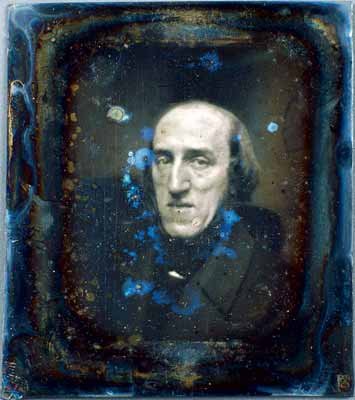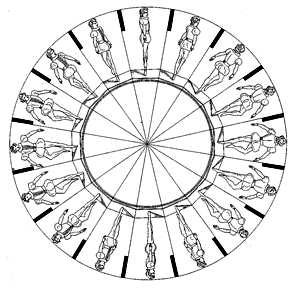<Back to Index>
- Physicist Joseph Antoine Ferdinand Plateau, 1801
- Composer Ciprian Porumbescu, 1853
- 1st Taoiseach of Ireland Éamon de Valera, 1882
PAGE SPONSOR


Joseph Antoine Ferdinand Plateau (October 14, 1801 – September 15, 1883) was a Belgian physicist. He was the first person to demonstrate the illusion of a moving image. To do this he used counter rotating disks with repeating drawn images in small increments of motion on one and regularly spaced slits in the other. He called this device of 1832 the phenakistoscope.
Born in Brussels, he studied at the University of Liège (Liège), where he graduated as a doctor of physical and mathematical sciences in 1829. In 1827 he became a teacher of mathematics at the "Atheneum" school in Brussels. In 1835, he was appointed Professor of experimental physics in Ghent University.
In
1829 Joseph Plateau submitted his doctoral thesis to his mentor Adolphe
Quetelet (1796 – 1874) for advice. It contained only 27 pages, but
formulated a great number of fundamental conclusions. It contained the
first results of his research into the effect of colours on the retina
(duration, intensity and colour), his mathematical research into the
intersections of revolving curves (locus),
the observation of the distortion of moving images, and the
reconstruction of distorted images through counter revolving discs (he
dubbed these anorthoscopic discs). In 1832, Plateau invented an early stroboscopic device, the "phenakistoscope",
the first device to give the illusion of a moving image. It consisted
of two disks, one with small equidistant radial windows, through which
the viewer could look, and another containing a sequence of images.
When the two disks rotated at the correct speed, the synchronization of
the windows and the images created an animated effect. The projection
of stroboscopic photographs, creating the illusion of motion,
eventually led to the development of cinema. Plateau also studied the phenomena of capillary action and surface tension (Statique expérimentale et théorique des liquides soumis aux seules forces moléculaires, 1873). The mathematical problem of existence of a minimal surface with a given boundary is named for him. He conducted extensive studies of soap films and formulated Plateau's laws which describe the structures formed by such films in foams. Fascinated by the persistence of luminous impressions on the retina, he performed an experiment in which he gazed directly into the sun for 25 seconds. Consequently, he lost his eyesight later in his life. He died in Ghent.